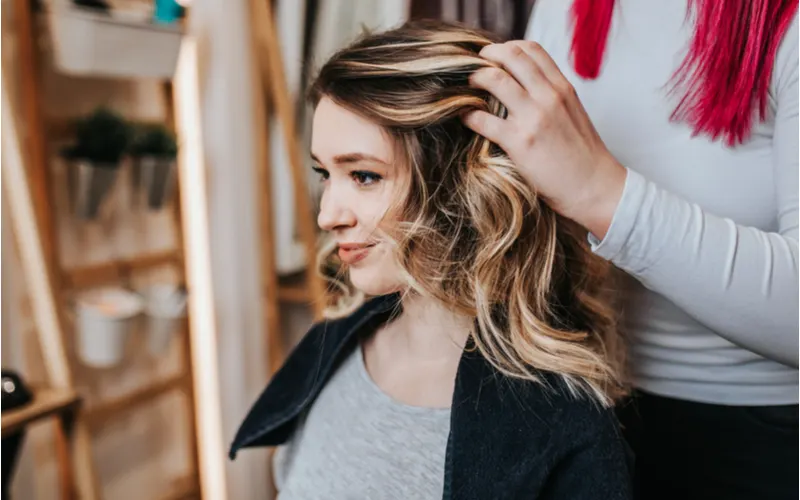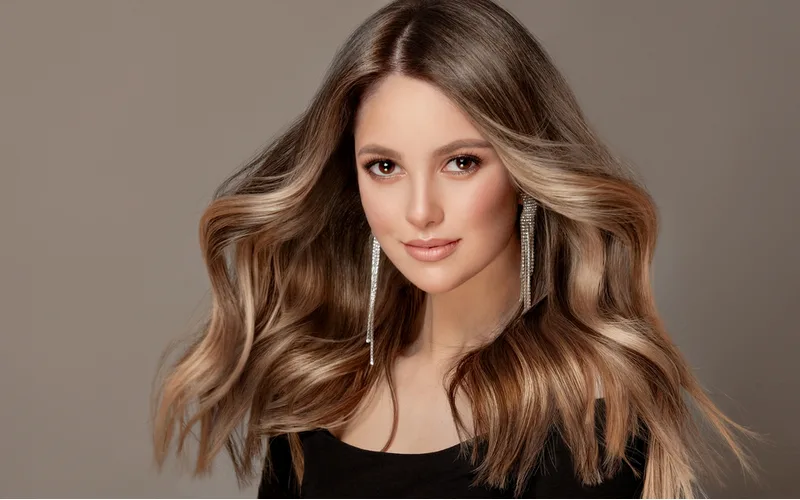Jump to:
If you’re deciding between highlights vs single-process hair color to change up your look and revamp your style, it can be a hard decision. Which one is better for your long-term hair health, lasts longer, and is less expensive? Read on to find out.
Highlights vs. Single-Process Hair Color: A Summary
Highlights are a coloring technique involving lightening your hair strands to achieve a lighter and more natural color.
If your base color, or the color of your roots, is dark brown or darker blonde, highlights can add light to the roots and strands of your hair to achieve a more springtime or summer-focused look.
- Highlighting involves foils that help separate strands of hair to make the new sections of color really ‘pop’ and make an impact.
- Another method that can be used with highlighting is hair painting, a freehand technique that creates a more natural and sun-kissed look than foils.
- Other typical hair-highlighting techniques involve fasting and chunking, both highlighting styles that either make the ends much lighter or use later sections of hair strands to create a more pronounced contrast than slimmer strands.
On the other hand, single-process hair color is the process of coloring hair all in one go at the salon.
Single-process color is a “vague” hairdressing term that can refer to any coloring service requiring only one salon visit, such as a root touch-up, root coloring, or base color applied from the roots to the ends.
- Single-process color is arguably the best option for those who want to achieve lowlights to tone down the brightness of their natural color. Just like highlights, stylists can do this by using foils or balayage to tone the hair.
- This technique is also the top choice for those who want to get rid of those stubborn grays coming in through the roots. Single process can help retouch the permanent color and cover grays in just one trip to the salon!
- Lastly, single-process color is arguably the best way to achieve a more gradual lightening look than a single highlighting appointment. For those who want to achieve a warmer and lighter look in their hair, using a single-process color can help do this in a healthier and more natural way.
Benefits of Highlights

Hedgehog94/Shutterstock
There are many benefits of choosing highlights instead of single-process color. Highlighting creates a natural look that is longer-lasting and easier to maintain than you would find with all-over color and bleaching.
But why should you choose highlights over single-process color? Check out the best times when you should ask your stylist for highlights instead of a single-process appointment at your local salon!
Sun-Kissed and Natural Look
One of the main benefits of using highlights is that you can achieve a more sun-kissed and natural look than a one-time color. Using highlighting techniques like balayage and freehand painting can create unique color strands and waves in the hair that look like you have been out in the sun all day!
Multi-Dimensional
Compared to single-process hair color, where all of the color is applied to one section at one time, the highlighting technique is multi-dimensional. It creates a more dramatic and eye-popping look than a uniform coloring process.
Easier Maintenance
Lastly, compared to single-process color, highlighting is easier to maintain and less costly on your wallet.
Instead of visiting the salon every 4-6 weeks for your root touch-up or bleach, you can head to the salon every 2-3 months to add more highlights, start your ombre treatment, or continue with your balayage process.
Read Next: How Often Should You Dye Your Hair?
Benefits of Single-Process Hair Color

Sofia Zhuravetc/Shutterstock
On the other hand, using single-process color is an excellent technique for people with certain hairstyles, textures, or colors. But when should you choose a single-process color over highlights, balayage, or ombre? There are a few scenarios in which single-process hair color can help you achieve your desired look more naturally.
Good for Short Hair
One of the main perks of choosing a single-process hair color is the effectiveness for those with short hair. Did you just recently get a pixie cut and want to dramatize your look?
Consider using a single-process color to add a new shade to your locks — something that would be pretty difficult with the freehand highlighting technique.
Adding Warmth
Compared to highlighting, single-process color can be an effective way to add warmth and honey tones to your hair.
Although highlighting is excellent for adding white, light blonde, platinum, and brassy tones to increase the lightness, single-process hair color is usually a top choice for those who want to add caramel, honey, and sun-toned highlights.
Darkening Your Hair
The third benefit of choosing a single hair color is that it can let you quickly darken your entire cut without going to multiple appointments. Single-process color can let you tone down your roots, mid shafts, and ends with one salon visit, saving your time, money, and energy.
Gentler on Your Hair
Lastly, using single-process color is typically gentler and easier on your strands than highlighting. This type of coloring technique does not use as many harsh chemicals or scalp-heavy treatments, making this a smart choice for those who are considering getting multiple root touch-ups and color appointments in a short time period.
How to Choose Between Highlights Vs Single-Process Color
Those who want to switch their look need to consider a few factors before immediately booking their salon appointment. Although you might have a picture in your mind of what you want the end product to look like, getting there is tricky.
Do you want a more maintenance-free technique that you only have to deal with once every three months, or would you rather have a more dramatic look that takes constant upkeep.
Learn the best way to decide between highlighting and single-process color before scheduling a consultation with your stylist.
Upkeep and Maintenance
One of the most important things to consider before choosing between highlighting and single-process color is the maintenance factor. Although you may want to bleach your roots and get rid of grays, keep in mind that this can be a more time-consuming endeavor that will require a trip to the salon every 4-6 weeks.
On the other hand, highlighting is a technique that will let you skimp on weekly maintenance and get touch-ups just every 2-3 months — great for busy people who just can’t pencil in a salon visit!
Style
The second factor influencing your decision as to what treatment you want is the end style. Do you want a more dramatic look, or do you like a natural, glowy, and sun-kissed aesthetic?
Choosing what style you are going for can help you decide between a dramatic, eye-turning “POP” and a more subtle and refined color.
Cost
The last factor that can determine what styling and coloring technique is best for you is the cost. Although hair coloring is going to be expensive no matter what, reducing the salon visits can help you save quite a bit over the term of a year.
Especially considering the average price of a single-process color at a high-end salon is $100! Are you really content with spending hundreds of dollars every 4-6 weeks, or would you rather budget your money?
Read Next: Average Hair Highlights Cost
Frequently Asked Questions

Schankz/Shutterstock
Before heading to the salon and scheduling your next appointment, you need to ensure your selection.
Do you want all-over highlights that brighten your summer look, or would you rather tone down your hair for a more subtle and relaxed vibe? Read these common questions and answers before talking to your hairstylist!
Is it possible to get both highlights and single-process color?
For some individuals, it may seem beneficial to get both highlights and single-process color. If you find that you want to cover some aspects of your roots, such as very light hair or gray roots, using a single-process color can get rid of any unwanted color in your hair.
Plus, once you cover up the unwanted color, your stylist can then use highlights to add extra volume, dimension, and that “va-va voom” look you want for your hair!
What is the double process color?
Are you considering getting a double process color instead of a single process? Usually, double process color is the best practice to use when you want to turn your dark brown or dark blonde hair into a platinum blonde or light brown!
If this sounds like what you are going for, then a double process can be more time-effective than a single process.
In this technique, stylists will bleach out your natural color and apply the desired color. However, keep in mind that this technique can be harsher on your roots and hair over time.
What is the price of highlighting vs single-process color?
Cost is often the deciding factor in your hair coloring decisions. The average price for a single-process base color is $75 at mid-range salons, whereas the more high-end boutique salons charge a minimum of $100 for this service.
The price of highlighting is much more costly, coming to between $150-$200 depending on the condition of your hair and the length. However, the deciding factor of the overall cost in the long-term is the frequency of the salon appointments, with highlighting requiring less-frequent visits.
Are there any downsides to highlighting?
Although highlighting is better for you than bleaching your roots, it still has downsides. Highlighting, especially too frequently, can dry out your hair, fade over time, and discolor when exposed to specific chemicals.
Even though highlighting is healthier for your hair since it only uses sections, the chemicals and coloring can still dry out your locks.
Are there any downsides to single-process color?
Don’t think that highlighting is the only process that can have potential drawbacks! Even though single-process color and highlighting are better than harshly bleaching your hair, there are still some potential disadvantages to single-process coloring that may deter you from using this coloring service.
The main cons of using single-process color instead of highlighting are that it can create a more dramatic look than intended, cause allergic reactions, and become harder to change.
If you are not thrilled with the final product, you may have to wait a few weeks to re-dye your hair to avoid permanent breakage of your roots and ends.
Highlights vs. Single-Process Color: Which Is Right for You?
Now that you understand the main differences between highlighting and single-process color, it is time to venture to the salon to get your new and improved look. After all, there is no point in spending money on a new root color that you can’t afford to maintain!
Using our foolproof hair care style guide, you can determine which hair coloring technique is best for your personal style, upkeep and maintenance routine, and budget.
